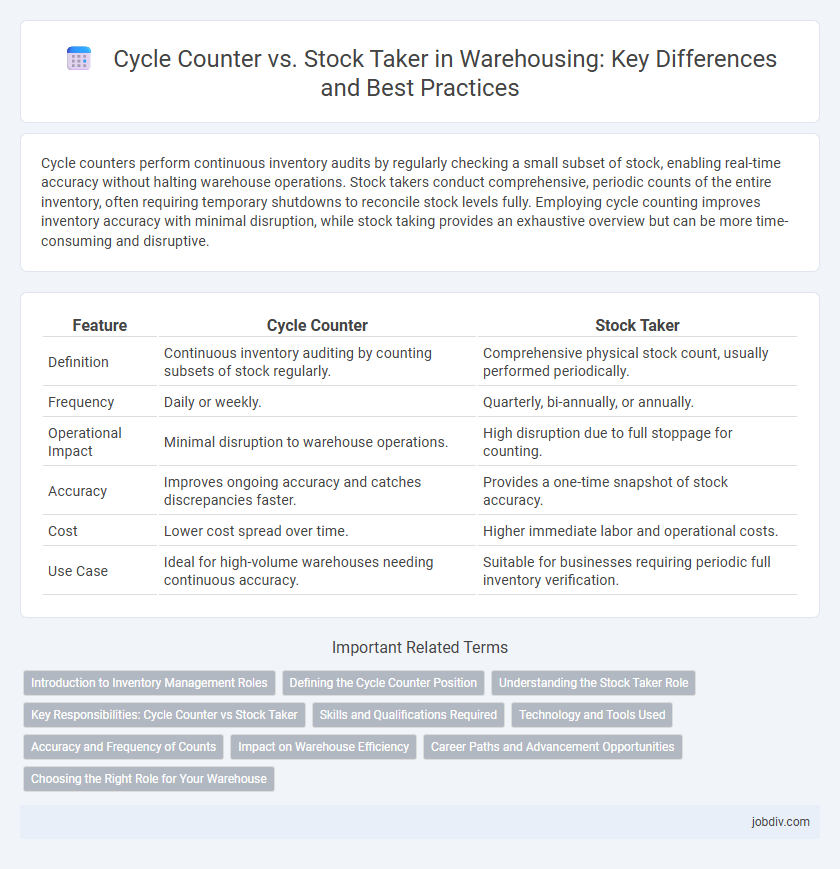Cycle counters perform continuous inventory audits by regularly checking a small subset of stock, enabling real-time accuracy without halting warehouse operations. Stock takers conduct comprehensive, periodic counts of the entire inventory, often requiring temporary shutdowns to reconcile stock levels fully. Employing cycle counting improves inventory accuracy with minimal disruption, while stock taking provides an exhaustive overview but can be more time-consuming and disruptive.
Table of Comparison
| Feature | Cycle Counter | Stock Taker |
|---|---|---|
| Definition | Continuous inventory auditing by counting subsets of stock regularly. | Comprehensive physical stock count, usually performed periodically. |
| Frequency | Daily or weekly. | Quarterly, bi-annually, or annually. |
| Operational Impact | Minimal disruption to warehouse operations. | High disruption due to full stoppage for counting. |
| Accuracy | Improves ongoing accuracy and catches discrepancies faster. | Provides a one-time snapshot of stock accuracy. |
| Cost | Lower cost spread over time. | Higher immediate labor and operational costs. |
| Use Case | Ideal for high-volume warehouses needing continuous accuracy. | Suitable for businesses requiring periodic full inventory verification. |
Introduction to Inventory Management Roles
Cycle counters perform regular, partial audits of inventory to maintain accuracy and reduce discrepancies throughout the year. Stock takers conduct comprehensive, full inventory counts typically at set intervals, which provide a complete snapshot of inventory levels. Both roles are essential in inventory management, ensuring data reliability and supporting efficient warehouse operations.
Defining the Cycle Counter Position
The cycle counter role involves regularly auditing and verifying inventory levels within a warehouse to ensure data accuracy and minimize discrepancies. Unlike traditional stock takers who perform full inventory counts infrequently, cycle counters conduct continuous, scheduled counts of specific sections or product categories. This targeted approach enhances inventory control, reduces operational disruptions, and supports real-time stock management in warehousing operations.
Understanding the Stock Taker Role
The stock taker plays a critical role in warehousing by conducting comprehensive physical inventory counts to verify stock accuracy and identify discrepancies. Unlike cycle counters who perform routine, scheduled counts on specific inventory segments, stock takers typically carry out full stock audits during shutdowns or periodic reviews. Their detailed assessments ensure data integrity for warehouse management systems, supporting accurate reporting and efficient inventory control.
Key Responsibilities: Cycle Counter vs Stock Taker
Cycle counters continuously monitor inventory accuracy through scheduled audits and real-time data verification, ensuring discrepancies are quickly identified and corrected. Stock takers perform comprehensive physical counts typically during shutdowns or stock-taking periods, focusing on validating overall inventory levels and reporting significant variances. Both roles are critical for maintaining inventory integrity but differ in frequency, methodology, and scope of responsibilities.
Skills and Qualifications Required
Cycle counters require strong analytical skills, attention to detail, and proficiency with inventory management software to perform frequent partial stock audits accurately. Stock takers must possess physical stamina, basic mathematical abilities, and familiarity with barcode scanning technology to conduct comprehensive, periodic inventory counts. Both roles benefit from organizational skills and the capability to work independently in fast-paced warehouse environments.
Technology and Tools Used
Cycle counters utilize advanced barcode scanners and RFID technology to conduct frequent, real-time inventory checks, enhancing accuracy and reducing downtime. Stock takers often rely on manual methods or standard handheld devices, which may increase counting time and error risk. Warehouse Management Systems (WMS) integrated with mobile counting tools further empower cycle counters by streamlining data collection and synchronization.
Accuracy and Frequency of Counts
Cycle counters enhance inventory accuracy by performing frequent, targeted counts on specific SKU segments, allowing for immediate discrepancy identification and correction. Stock takers typically conduct comprehensive counts less often, which may result in delayed error detection and lower overall inventory precision. Frequent cycle counting reduces stock variances and improves real-time data reliability compared to periodic full stock taking.
Impact on Warehouse Efficiency
Cycle counters enhance warehouse efficiency by performing frequent, targeted inventory checks that reduce downtime and maintain accuracy without halting operations. Stock takers typically require complete inventory shutdowns for periodic counts, leading to significant operational disruptions and decreased productivity. Implementing cycle counting minimizes errors and supports continuous workflow, optimizing overall warehouse management.
Career Paths and Advancement Opportunities
Cycle counters often develop specialized skills in inventory accuracy and data analysis, positioning them for roles such as Inventory Control Specialist or Warehouse Supervisor. Stock takers typically gain broad experience across multiple warehouse functions, enabling transitions into roles like Logistics Coordinator or Operations Manager. Both paths offer advancement through certifications in supply chain management and proficiency in warehouse management systems.
Choosing the Right Role for Your Warehouse
Cycle counters provide continuous inventory accuracy by regularly auditing selected stock segments, minimizing disruption and enabling real-time data updates. Stock takers perform comprehensive, periodic counts, ideal for full inventory verification but may require temporary operational pauses. Selecting the right role depends on warehouse size, inventory turnover rate, and the need for ongoing accuracy versus periodic reconciliation.
Cycle Counter vs Stock Taker Infographic

 jobdiv.com
jobdiv.com